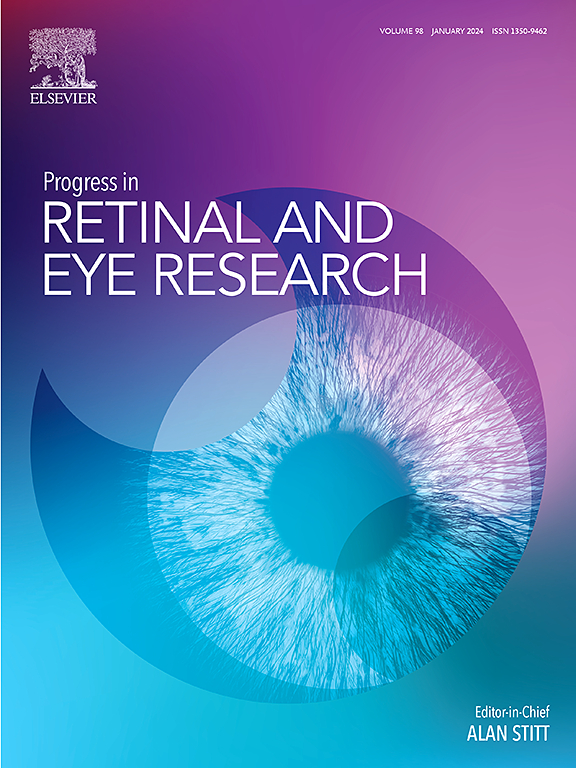Understanding glaucoma as astrocyte-driven neurodegeneration in the optic nerve head: an integrative clinicopathological perspective
IF 14.7
1区 医学
Q1 OPHTHALMOLOGY
引用次数: 0
Abstract
Glaucoma is characterized by the progressive loss of retinal ganglion cells (RGCs), primarily driven by axonal degeneration within the optic nerve head (ONH). Recent advances in neurodegeneration and neuroinflammation research have opened new astrocyte-centered perspectives on glaucoma pathogenesis. Critical evaluation of emerging evidence suggests that ONH astrocyte changes may serve as the primary driver of pathogenesis, with loss of astrocytic support playing a substantial role. Evidence from experimental glaucoma models reveals that early intraocular pressure (IOP)-induced remodeling of the ONH astrocyte network precedes RGC axonal damage, potentially mediated by impaired astrocytic control of electrophysiological homeostasis within the surrounding extracellular space. Furthermore, the heterogeneous glia-neuron ratio (GNR) across the normal human ONH lamina cribrosa exhibits an inverse topographic association with the spatiotemporal pattern of regional vulnerability observed clinically in glaucoma, suggesting that regional variations in the astrocyte-to-neuron ratio, reflecting astrocytic support reserve, may critically determine local tissue susceptibility to glaucomatous stress. Recent optical coherence tomography–based insights into the regional vulnerability in human glaucoma are discussed. This clinicopathological interpretation may offer a comprehensive framework that coherently integrates diverse neurodegenerative mechanisms into a unified clinical entity, bridge the conventional mechanical and ischemic theories of glaucoma by highlighting astrocyte changes as a common primary target of risk factors, and ultimately redefine glaucoma as astrocyte-driven neurodegeneration in the biomechanically and bioenergetically vulnerable ONH.
理解青光眼作为视神经头星形细胞驱动的神经变性:一个综合的临床病理观点
青光眼的特点是视网膜神经节细胞(RGCs)的进行性丧失,主要是由视神经头(ONH)内的轴突变性引起的。神经变性和神经炎症研究的最新进展为以星形胶质细胞为中心的青光眼发病机制开辟了新的视角。对新证据的批判性评估表明,ONH星形胶质细胞的变化可能是发病机制的主要驱动因素,星形胶质细胞支持的丧失起着重要作用。来自青光眼实验模型的证据表明,早期眼压(IOP)诱导的ONH星形胶质细胞网络重塑先于RGC轴突损伤,可能是由周围细胞外空间星形胶质细胞对电生理稳态的控制受损介导的。此外,在青光眼临床观察中,正常人ONH网层的异质胶质-神经元比率(GNR)与区域易感性时空模式呈负相关,表明星形细胞-神经元比率的区域差异反映了星形细胞支持储备,可能在很大程度上决定了局部组织对青光眼应激的易感性。最近的光学相干断层扫描为基础的见解,在人类青光眼的区域脆弱性进行了讨论。这种临床病理解释可能提供一个全面的框架,将多种神经退行性机制整合到一个统一的临床实体中,通过突出星形细胞变化作为危险因素的共同主要目标,将青光眼的传统力学和缺血性理论联系起来,并最终将青光眼重新定义为生物力学和生物能量易感的ONH中星形细胞驱动的神经退行性变。
本文章由计算机程序翻译,如有差异,请以英文原文为准。
求助全文
约1分钟内获得全文
求助全文
来源期刊
CiteScore
34.10
自引率
5.10%
发文量
78
期刊介绍:
Progress in Retinal and Eye Research is a Reviews-only journal. By invitation, leading experts write on basic and clinical aspects of the eye in a style appealing to molecular biologists, neuroscientists and physiologists, as well as to vision researchers and ophthalmologists.
The journal covers all aspects of eye research, including topics pertaining to the retina and pigment epithelial layer, cornea, tears, lacrimal glands, aqueous humour, iris, ciliary body, trabeculum, lens, vitreous humour and diseases such as dry-eye, inflammation, keratoconus, corneal dystrophy, glaucoma and cataract.

 求助内容:
求助内容: 应助结果提醒方式:
应助结果提醒方式:


